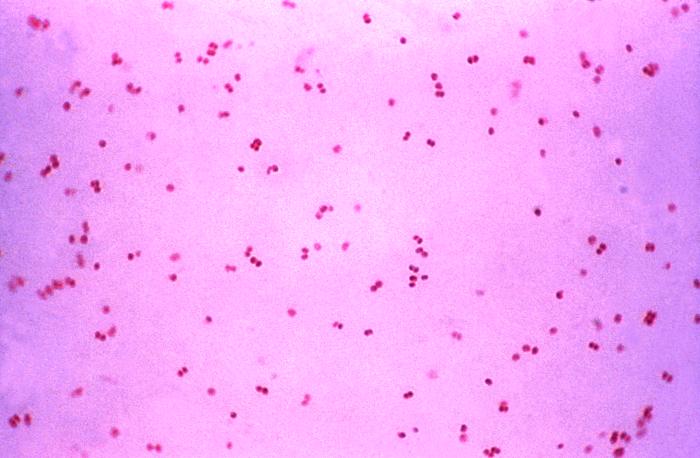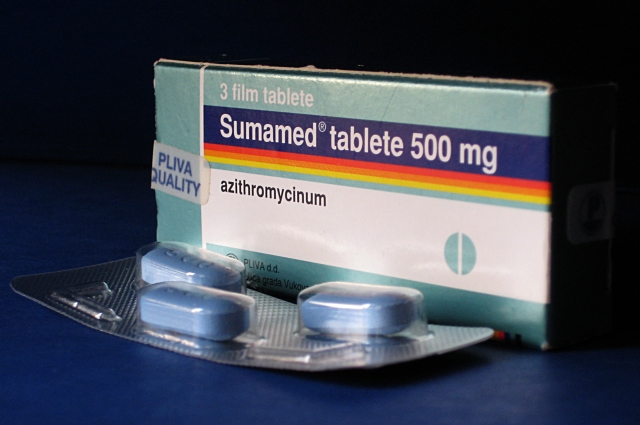|
Antibiotic Resistance In Gonorrhea
''Neisseria gonorrhoeae'', the bacterium that causes the sexually transmitted infection gonorrhea, has developed antibiotic resistance to many antibiotics. The bacteria was first identified in 1879. In the 1940s effective treatment with penicillin became available, but by the 1970s resistant strains predominated. Resistance to penicillin has developed through two mechanisms: chromosomally mediated resistance (CMRNG) and penicillinase-mediated resistance (PPNG). CMRNG involves step wise mutation of penA, which codes for the penicillin-binding protein (PBP-2); mtr, which encodes an efflux pump that removes penicillin from the cell; and penB, which encodes the bacterial cell wall porins. PPNG involves the acquisition of a plasmid-borne beta-lactamase. ''N. gonorrhoeae'' has a high affinity for horizontal gene transfer, and as a result, the existence of any strain resistant to a given drug could spread easily across strains. Fluoroquinolones were a useful next-line treatment until r ... [...More Info...] [...Related Items...] OR: [Wikipedia] [Google] [Baidu] |
Ceftriaxone
Ceftriaxone, sold under the brand name Rocephin, is a third-generation cephalosporin antibiotic used for the treatment of a number of bacterial infections. These include middle ear infections, endocarditis, meningitis, pneumonia, bone and joint infections, intra-abdominal infections, skin infections, urinary tract infections, gonorrhea, and pelvic inflammatory disease. It is also sometimes used before surgery and following a bite wound to try to prevent infection. Ceftriaxone can be given by injection into a vein or into a muscle. Common side effects include pain at the site of injection and allergic reactions. Other possible side effects include ''C. difficile''-associated diarrhea, hemolytic anemia, gall bladder disease, and seizures. It is not recommended in those who have had anaphylaxis to penicillin but may be used in those who have had milder reactions. The intravenous form should not be given with intravenous calcium. There is tentative evidence that ceftriaxone is ... [...More Info...] [...Related Items...] OR: [Wikipedia] [Google] [Baidu] |
Antibiotic Resistance
Antimicrobial resistance (AMR) occurs when microbes evolve mechanisms that protect them from the effects of antimicrobials. All classes of microbes can evolve resistance. Fungi evolve antifungal resistance. Viruses evolve antiviral resistance. Protozoa evolve antiprotozoal resistance, and bacteria evolve antibiotic resistance. Those bacteria that are considered extensively drug resistant (XDR) or totally drug-resistant (TDR) are sometimes called "superbugs".A.-P. Magiorakos, A. Srinivasan, R. B. Carey, Y. Carmeli, M. E. Falagas, C. G. Giske, S. Harbarth, J. F. Hinndler ''et al''Multidrug-resistant, extensively drug-resistant and pandrug-resistant bacteria... Clinical Microbiology and Infection, Vol 8, Iss. 3 first published 27 July 2011 ia Wiley Online Library Retrieved 28 August 2020 Although antimicrobial resistance is a naturally-occurring process, it is often the result of improper usage of the drugs and management of the infections. Antibiotic resistance is a major su ... [...More Info...] [...Related Items...] OR: [Wikipedia] [Google] [Baidu] |
Ceftriaxone
Ceftriaxone, sold under the brand name Rocephin, is a third-generation cephalosporin antibiotic used for the treatment of a number of bacterial infections. These include middle ear infections, endocarditis, meningitis, pneumonia, bone and joint infections, intra-abdominal infections, skin infections, urinary tract infections, gonorrhea, and pelvic inflammatory disease. It is also sometimes used before surgery and following a bite wound to try to prevent infection. Ceftriaxone can be given by injection into a vein or into a muscle. Common side effects include pain at the site of injection and allergic reactions. Other possible side effects include ''C. difficile''-associated diarrhea, hemolytic anemia, gall bladder disease, and seizures. It is not recommended in those who have had anaphylaxis to penicillin but may be used in those who have had milder reactions. The intravenous form should not be given with intravenous calcium. There is tentative evidence that ceftriaxone is ... [...More Info...] [...Related Items...] OR: [Wikipedia] [Google] [Baidu] |
Beta-lactam Antibiotics Example 1
A beta-lactam (β-lactam) ring is a four-membered lactam. A ''lactam'' is a cyclic amide, and ''beta''-lactams are named so because the nitrogen atom is attached to the β-carbon atom relative to the carbonyl. The simplest β-lactam possible is 2-azetidinone. β-lactams are significant structural units of medicines as manifested in many β-lactam antibiotics Up to 1970, most β-lactam research was concerned with the penicillin and cephalosporin groups, but since then, a wide variety of structures have been described. Clinical significance The β-lactam ring is part of the core structure of several antibiotic families, the principal ones being the penicillins, cephalosporins, carbapenems, and monobactams, which are, therefore, also called β-lactam antibiotics. Nearly all of these antibiotics work by inhibiting bacterial cell wall biosynthesis. This has a lethal effect on bacteria, although any given bacteria population will typically contain a subgroup that is resistan ... [...More Info...] [...Related Items...] OR: [Wikipedia] [Google] [Baidu] |
Penicillin Cures Gonorrhea
Penicillins (P, PCN or PEN) are a group of β-lactam antibiotics originally obtained from ''Penicillium'' moulds, principally ''P. chrysogenum'' and '' P. rubens''. Most penicillins in clinical use are synthesised by P. chrysogenum using deep tank fermentation and then purified. A number of natural penicillins have been discovered, but only two purified compounds are in clinical use: penicillin G (intramuscular or intravenous use) and penicillin V (given by mouth). Penicillins were among the first medications to be effective against many bacterial infections caused by staphylococci and streptococci. They are still widely used today for different bacterial infections, though many types of bacteria have developed resistance following extensive use. 10% of the population claims penicillin allergies but because the frequency of positive skin test results decreases by 10% with each year of avoidance, 90% of these patients can tolerate penicillin. Additionally, those with peni ... [...More Info...] [...Related Items...] OR: [Wikipedia] [Google] [Baidu] |
Tetracycline
Tetracycline, sold under various brand names, is an oral antibiotic in the tetracyclines family of medications, used to treat a number of infections, including acne, cholera, brucellosis, plague, malaria, and syphilis. Common side effects include vomiting, diarrhea, rash, and loss of appetite. Other side effects include poor tooth development if used by children less than eight years of age, kidney problems, and sunburning easily. Use during pregnancy may harm the baby. It works by inhibiting protein synthesis in bacteria. Tetracycline was patented in 1953 and came into commercial use in 1978. It is on the World Health Organization's List of Essential Medicines. Tetracycline is available as a generic medication. Tetracycline was originally made from bacteria of the genus ''Streptomyces''. Medical uses Spectrum of activity Tetracyclines have a broad spectrum of antibiotic action. Originally, they possessed some level of bacteriostatic activity against almost all medi ... [...More Info...] [...Related Items...] OR: [Wikipedia] [Google] [Baidu] |
Aminoglycosides
Aminoglycoside is a medicinal and bacteriologic category of traditional Gram-negative antibacterial medications that inhibit protein synthesis and contain as a portion of the molecule an amino-modified glycoside ( sugar). The term can also refer more generally to any organic molecule that contains amino sugar substructures. Aminoglycoside antibiotics display bactericidal activity against Gram-negative aerobes and some anaerobic bacilli where resistance has not yet arisen but generally not against Gram-positive and anaerobic Gram-negative bacteria.ME Levison, MD, 2012, Aminoglycosides, The Merck Manua accessed 22 February 2014. Streptomycin is the first-in-class aminoglycoside antibiotic. It is derived from ''Streptomyces griseus'' and is the earliest modern agent used against tuberculosis. Streptomycin lacks the common 2-deoxystreptamine moiety (image right, below) present in most other members of this class. Other examples of aminoglycosides include the deoxystreptamine-containi ... [...More Info...] [...Related Items...] OR: [Wikipedia] [Google] [Baidu] |
Cephalosporin
The cephalosporins (sg. ) are a class of β-lactam antibiotics originally derived from the fungus '' Acremonium'', which was previously known as ''Cephalosporium''. Together with cephamycins, they constitute a subgroup of β-lactam antibiotics called cephems. Cephalosporins were discovered in 1945, and first sold in 1964. Discovery The aerobic mold which yielded cephalosporin C was found in the sea near a sewage outfall in Su Siccu, by Cagliari harbour in Sardinia, by the Italian pharmacologist Giuseppe Brotzu in July 1945. Structure Cephalosporin contains a 6-membered dihydrothiazine ring. Substitutions at position 3 generally affect pharmacology; substitutions at position 7 affect antibacterial activity, but these cases are not always true. Medical uses Cephalosporins can be indicated for the prophylaxis and treatment of infections caused by bacteria susceptible to this particular form of antibiotic. First-generation cephalosporins are active predominantly ... [...More Info...] [...Related Items...] OR: [Wikipedia] [Google] [Baidu] |
Cefixime
Cefixime, sold under the brand name Suprax among others, is an antibiotic medication used to treat a number of bacterial infections. These infections include otitis media, strep throat, pneumonia, urinary tract infections, gonorrhea, and Lyme disease. For gonorrhea typically only one dose is required. In the United States it is a second-line treatment to ceftriaxone for gonorrhea. It is taken by mouth. Common side effects include diarrhea, abdominal pain, and nausea. Serious side effects may include allergic reactions and ''Clostridium difficile'' diarrhea. It is not recommended in people with a history of a severe penicillin allergy. It appears to be relatively safe during pregnancy. It is in the third-generation cephalosporin class of medications. It works by disrupting the bacteria's cell wall resulting in its death. Cefixime was patented in 1979 and approved for medical use in the United States in 1989. It is on the World Health Organization's List of Essential Medicines ... [...More Info...] [...Related Items...] OR: [Wikipedia] [Google] [Baidu] |
Doxycycline
Doxycycline is a broad-spectrum tetracycline class antibiotic used in the treatment of infections caused by bacteria and certain parasites. It is used to treat bacterial pneumonia, acne, chlamydia infections, Lyme disease, cholera, typhus, and syphilis. It is also used to prevent malaria in combination with quinine. Doxycycline may be taken by mouth or by injection into a vein. Common side effects include diarrhea, nausea, vomiting, abdominal pain, and an increased risk of sunburn. Use during pregnancy is not recommended. Like other agents of the tetracycline class, it either slows or kills bacteria by inhibiting protein production. It kills malaria by targeting a plastid organelle, the apicoplast. Doxycycline was patented in 1957 and came into commercial use in 1967. It is on the World Health Organization's List of Essential Medicines. Doxycycline is available as a generic medicine. In 2020, it was the 79th most commonly prescribed medication in the United States ... [...More Info...] [...Related Items...] OR: [Wikipedia] [Google] [Baidu] |
Azithromycin
Azithromycin, sold under the brand names Zithromax (in oral form) and Azasite (as an eye drop), is an antibiotic medication used for the treatment of a number of bacterial infections. This includes middle ear infections, strep throat, pneumonia, traveler's diarrhea, and certain other intestinal infections. Along with other medications, it may also be used for malaria. It can be taken by mouth or intravenously. Common side effects include nausea, vomiting, diarrhea and upset stomach. An allergic reaction, such as anaphylaxis, QT prolongation, or a type of diarrhea caused by ''Clostridium difficile'' is possible. No harm has been found with its use during pregnancy. Its safety during breastfeeding is not confirmed, but it is likely safe. Azithromycin is an azalide, a type of macrolide antibiotic. It works by decreasing the production of protein, thereby stopping bacterial growth. Azithromycin was discovered in 1980 by the Yugoslav pharmaceutical company Pliva ... [...More Info...] [...Related Items...] OR: [Wikipedia] [Google] [Baidu] |




